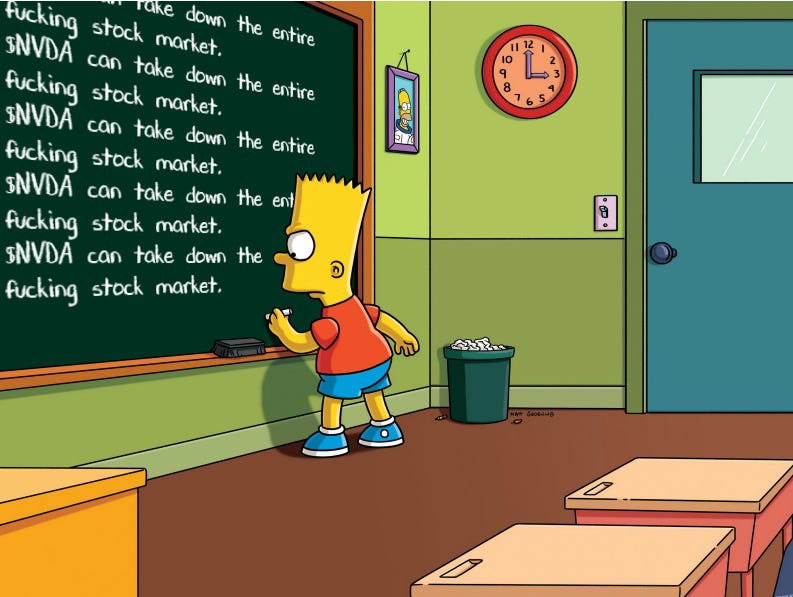Nvidia May Have Just Killed the Stock Market (Maybe)
Description
AI enthusiasm has pushed Nvidia to heights few would have imagined, humbling anyone who doubted its rise—including me. For nearly two years I argued the stock had outrun reality, yet Nvidia kept proving skeptics wrong. Its latest earnings only intensified the mania, raising an uncomfortable question: is this a historic technological boom, or a valuation that has drifted too far from earth?
A Quarter That Redefined “Blowout”
Nvidia’s third-quarter numbers didn’t just beat expectations—they obliterated them. Revenue hit $57 billion, up 62% from last year, with $32 billion in net income. The data-center business alone cleared $50 billion as every major cloud provider scrambled for AI hardware. CEO Jensen Huang called demand “off the charts,” insisting fears of an AI bubble were misplaced¹.
What really electrified the market, however, was Nvidia’s guidance: a projected $65 billion in fourth-quarter revenue, far above estimates². Shares jumped after hours, adding over $200 billion in market cap in a single session—more than the entire value of some blue-chip companies. One fund manager summed up the reaction: Nvidia’s report “soothed jitters over inflated valuations” and even fueled a global equity rally¹.
This is the sort of performance that makes Nvidia feel invincible. By late 2025, the company had surged past a $5 trillion valuation—up more than 1,100% in three years. Nvidia became not just an industry leader but the gravitational center of the entire stock market.
That’s where my concern begins.
A Great Company With a Priced-for-Perfection Stock
There’s no question Nvidia is an extraordinary business. It dominates the market for AI accelerators with near-monopolistic efficiency and boasts a visionary CEO with a clear technological roadmap. If any company deserves admiration, it’s Nvidia.
But admiration is not the same as investment merit at any price.
At $5 trillion, the market assumes Nvidia will grow at breakneck speed for many years without meaningful competition or macro setbacks. History suggests that is a fragile assumption.
Consider Cisco in the late 1990s. It was once crowned the most valuable company in the world and was viewed as the backbone of the internet revolution. When the dot-com bubble burst, its stock fell 85% and still hasn’t reclaimed its highs a quarter-century later²³. Cisco didn’t fail as a business; it failed to meet impossible expectations. Some analysts warn Nvidia could be walking into a similar dynamic⁴.
Nvidia’s valuation rests heavily on the present frenzy for AI infrastructure. But several risks are hiding in plain sight:
Export restrictions: U.S. limits on high-end chip sales to China have already reduced Nvidia’s access to one of the world’s largest markets.
Customer concentration: A handful of hyperscalers make up the bulk of demand.
Funding-driven demand: Some AI startups buying Nvidia hardware remain unprofitable and are using investor cash to fund purchases—creating a circular market dynamic.
Normalization ahead: Growth at this speed can’t continue forever. At some point, even a small deceleration would force investors to rethink the valuation.
At roughly 28× forward earnings, Nvidia doesn’t look extreme on traditional metrics. But those metrics assume earnings keep exploding. If growth slows even modestly, the multiple could ratchet dramatically higher overnight.
The Crowd Is All-In—And That’s the Problem
Crowd psychology can overpower fundamentals. Nvidia has become a story stock—AI is the future, Nvidia equals AI, therefore the stock must rise. Momentum has fed on itself: early buyers made huge gains, attracting new buyers who chased the rally higher.
But when everyone is already invested, who is left to push prices up?
That vulnerability flickered briefly when Nvidia fell about 9% from its highs ahead of earnings. Sentiment wobbled, however briefly. Its blowout quarter flipped the switch back to euphoria, but the weakness revealed how shaky the mood can be. When a stock becomes synonymous with investor confidence, even a minor disappointment can snowball.
Wall Street analysts insist concerns about an AI bubble are “greatly exaggerated,” and executives—including Huang—seem convinced nothing can derail the boom⁵. We’ve heard versions of that argument at every major market peak.
Meanwhile, the capital flowing into AI infrastructure is staggering. One estimate suggests $7 trillion will be required for data centers and supporting hardware by 2030. Much of that is being financed through debt or speculative investment—yet the market barely blinks. Risky financing structures from the dot-com era, like zero-coupon convertibles, have returned. When the crowd shrugs at leverage, it’s usually a late-cycle tell.
Concentration Risk: Nvidia Is the Market
A company of Nvidia’s size inevitably reshapes the broader market. It now represents a major slice of the S&P 500 and the Nasdaq, effectively dictating index performance. When Nvidia rallies, indexes rally. When Nvidia stumbles, indexes feel it.
We saw this in October when Nvidia’s weakness helped drag the Nasdaq into correction territory. Strategists openly wondered whether a breakdown in Nvidia could “sink investor sentiment” across the market. They were not exaggerating. The market’s dependence on a handful of mega-cap names—often called the “Magnificent Seven”—is the highest in decades.
It’s a double-edged sword: Nvidia has lifted the market on its back, but the same dynamic means a significant Nvidia pullback could trigger broader volatility.
A Turning Point—Or the Start of a Final Melt-Up?
None of this means Nvidia is destined to crash. The company may very well justify its valuation over time. AI is real, transformative, and still early in its adoption cycle. Nvidia has built an enviable moat.
But investors must distinguish between a phenomenal business and a stock priced for perfection. If even a small crack appea







